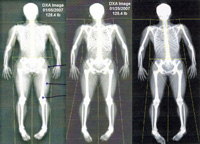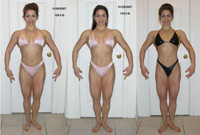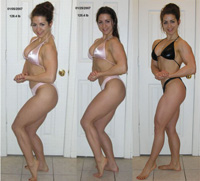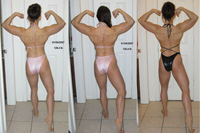 |
|||||||||||||||||||||||||||||||||||||||||||||||||||||||||||||||||||||||||||||||||||||||||||||||||||||||||||||||||||||||||||||||||||||||||||||||||||||||||||||||||||||
| | |
|
| |
| | |
||||||||||||||||||||||||||||||||||||||||||||||||||||||||||||||||||||||||||||||||||||||||||||||||||||||||||||||||||||||||||||||||||||||||||||||||||||||||||||||
| |
|||||||||||||||||||||||||||||||||||||||||||||||||||||||||||||||||||||||||||||||||||||||||||||||||||||||||||||||||||||||||||||||||||||||||||||||||||||||||||||||||||||
| |
|
||||||||||||||||||||||||||||||||||||||||||||||||||||||||||||||||||||||||||||||||||||||||||||||||||||||||||||||||||||||||||||||||||||||||||||||||||||||||||||||||||||
|
March Update Jean Jitomir Contest Prep by Jean Jitomir
The following is an update for my NPC Jr. USA contest prep. As an Exercise Nutrition PhD student, I am fortunate to have access to equipment that allows me to closely track the changes that are happening in my body. Every three weeks I have been collecting 1) weight; 2) BMI; 3) Whole Body and Lumbar DXA Scan; 4) Resting Energy Expenditure; 5) Multi-Frequency BIA; 6) Handheld BIA; 7) Lange Calipers; 8) Circumference Measures; and more recently 9) Whole blood analysis. There is short description of each test and my results from the first three sessions below. For more details about the tests, please refer to my previous article. For some topics, there are links provided so you apply the test to yourself or read more information. All tests are done in the morning after fasting for 10 hours and are repeated approximately every three weeks- 6 total testing sessions will be done before the competition. I have bolded interesting changes:
Weight Weight is easy, cheap and can be done every morning. It’s also a very sensitive measure, which means that you can detect small changes. The trick, however, is figuring out were that weight is coming from! Is it fat, muscle or water? The best way to ensure that you’re not measuring water changes is to weigh yourself first thing in the morning, right after going to the bathroom and before eating. Whether you are loosing fat or muscle is a little bit of a mystery, but hopefully other measures can give us a clue there! I have lost about 6 pounds since I started reporting and a little over 8 pounds since Christmas. The loss is encouraging, but I still have about another 10-12 pounds to go. BMI The unitless BMI a quick way to estimate body fatness- my BMI at 22.5 is in the middle healthy range. In previous contests, my final BMI is usually between 20 and 21, which is on the bottom healthy range. Calculate your BMI: http://www.nhlbisupport.com/bmi/
Dual Energy X-ray Absorptiometry (DEXA or DXA)
DXA is the best way to measure bone mineral density and risk for osteoporosis. Bone density is a measurement of how much calcium and other minerals are packed into the skeleton. The denser your bones, the less likely they are to fracture. It is also the easiest and one of the most accurate ways to measure body fat.
My body fat, based on the DXA, is lowering but not by leaps and bounds. I would have expected to lose body fat faster in the beginning, since I have more to loose at this point; however, it seems as though I may be losing a fair amount of lean muscle mass. For instance, a value of 17.5% at 128.4 lbs and a loss to 17.2% at 122.8 lbs suggests a lean mass change from 105.9 lbs to 101.6, which indicates that 76% of the weight I’ve lost is from muscle or water and only 24% is from fat. As a female competitor, I am concerned about my bone health through the dieting process. The essential fat for a female is somewhere around 12%- to be prepared for a bodybuilding competition, the body fat should be lower than this. As such, I have NEVER prepared for a physique competition and maintained a period. In fact, last year I didn’t have one for nine months- my body fat during that period of time ranged between 10-15%. Last month’s was 10 days late and nearly absent. I’d venture a guess that it will be gone in the next update. Normal estrogen and female hormone levels are a very important for maintaining and gaining bone density. In fact, women in their early 20s should still be gaining bone density and chronic dieting for competition will impede this gain. Additionally, some nutritionists believe that a high-protein diet causes calcium to leave the bones. Is this optimally healthy? No. But I’m supplementing calcium, Vitamin D and Vitamin K in an attempt to minimize the bone calcium loss. The DXA measurements will help me to determine if I am losing bone mass during the dieting process. The lower spine DXA measurement is better than the whole body scan for telling whether or not I am loosing calcium- at the beginning, my lumbar Z-score was -0.5. That value meant I was at the 27th percentile for women of my age and ethnicity. In other words, 73% of 24 year old white women have denser bones in the lower spine than I do. If my Z-score reaches -1.0, I will be at increased risk for fracture in my lumbar spine. During the third session my value lowered again to -0.7 (I am now in the 24th percentile for women my age); this value shows a trend toward lower bone density in my spine. I have been told in classes you cannot see a change in bone density over this short period of time; however, if this trend continues, I may be able to stump a few know-it-all professors, not to mention put myself at a greater risk of a spine fracture. http://courses.washington.edu/bonephys
Resting Energy Expenditure (REE)
The REE is the number of calories used by the body in a fasting state, lying down, awake, not moving at all. My REE measurements were calculated by a Parvo metabolic cart. It works by measuring the amount of oxygen taken in and carbon dioxide exhaled to calculate the amount of energy the body is using.
More relevant to the contest prep, I will have a lot more trouble dropping the weight I need to with an REE this low because I am burning about 300 kcal less at rest than I was before. I’m not exactly sure what I’ll do to respond to my REE at this point. I will measure it a couple more times to make sure the machine was working properly and I will seek the advice of my professors to see what they think I should do in terms of cardio and diet. I did the latest REE about four days after changing to the 1200-1400 calorie phase of my diet (about 40% protein, 35% carbs and 25% fat). I am doing about 45-55 minutes of moderate cardio most days of the week at this point. Additionally, the theory behind a cheat day or meal is that the extra energy helps a person maintain her REE, which aids in weight loss. It is not certain that one cheat day or meal per week will help maintain a high REE; however, eating too much on a cheat day will definitely prevent weight and fat loss.
Multi-Frequency Bioelectrical Impedance (BIA)
BIA is the best way to measure water in the body. The BIA also calculates an estimate body fat; however, the BIA estimate of fat is not very accurate and is very sensitive to changes in body water. Based on the total body water changes from session 1 to session 2, which is equal to about 3.8 lbs of water, I believe that I was probably quite dehydrated during the third session, which indicates two things 1) some of the body fat tests could be inaccurate, since they tend to be pretty sensitive to water; and 2) my weight did not really change between testing session 2 and session 3. Handheld BIA
The handheld BIA is that little body fat contraption seen in many gyms- it is a rough estimate, however. My values came out about 3-4% higher than the more reliable DXA value. From what I’ve seen in the lab, values are usually within 3-5%. Lean and athletic people tend to show values that are too high on the handheld BIA, while sedentary people tend to come out a little closer to their actual values. The handheld BIA has been showing consistent body fat loss in each session. In the past, on a different handheld BIA that was the same model, I was at about 15.5% on the hand held BIA during the week of the contest. Lange Calipers
There are literally hundreds of caliper equations in existence. The best equation for you is based on your gender, ethnicity, age and many other factors. Furthermore, as many as 10 sites can be measured to plug into a formula- no less than 6 should be used.
The Jackson/Polluck formulas have been the best for me so far, as compared to the DXA. The Jackson/Polluck 7 was also less influenced by the funky thigh measurements I got. In the last testing session my thigh measurement went from 12.5 to 18.5. There is no way I gained a ton of fat on my thighs, so what happened? If you’ve ever done a contest, you probably noticed that your fat folds get far more pinchable as you lose weight and the skin is still stretched with less fat to fill it out. So in the thigh area, where it is hard to grab in the beginning, it is very hard to get a good measurement until you have lost a little weight. To learn how to measure with caliper, please see: http://www.exrx.net/Testing/SkinfoldProcedures.html To calculate your body fat from calipers, please see: http://www.linear-software.com/online.html Circumference Measures
For a physique competitor, a simple tape measure is one of your most useful tools! On a contest diet, your waist (and hips in my case) should shrink a whole bunch, while the arms shouldn’t show a dramatic drop. In combination with calipers, you may be able to tell whether you are losing inches from fat or muscle. My waist and hip measurements have dropped, which is a good sign. Generally, at contest time, my waist just under 25” and my hips are usually about 34”. Just look at yourself It’s a physique contest, right? So the most useful tool will cost you about $10- it’s a full length mirror. A close second are clear photos and you probably know someone with a digital camera. All the methods above are great and useful, but if your look isn’t aesthetically pleasing, it doesn’t really matter for physique competition. The most encouraging tool for me so far has definitely been my mirror. I’m getting chest definition, which there was not a trace of before. I have the first signs of good veins showing up in my legs and lower abs; the veins in my arms are starting to become embarrassing again. Check in next month to see what happens! Hopefully, I can get my REE back up and loose some body fat- only time will tell! |
|
|||||||||||||||||||||||||||||||||||||||||||||||||||||||||||||||||||||||||||||||||||||||||||||||||||||||||||||||||||||||||||||||||||||||||||||||||||||||||||||||||||
| |
|
||||||||||||||||||||||||||||||||||||||||||||||||||||||||||||||||||||||||||||||||||||||||||||||||||||||||||||||||||||||||||||||||||||||||||||||||||||||||||||||||||||
| |
|||||||||||||||||||||||||||||||||||||||||||||||||||||||||||||||||||||||||||||||||||||||||||||||||||||||||||||||||||||||||||||||||||||||||||||||||||||||||||||||||||||
 |
|
 |
|||||||||||||||||||||||||||||||||||||||||||||||||||||||||||||||||||||||||||||||||||||||||||||||||||||||||||||||||||||||||||||||||||||||||||||||||||||||||||||||||||
| |
|
|
|
|
|
|
|
|
|
|
|
|
|
|
|
|
|
|
|||||||||||||||||||||||||||||||||||||||||||||||||||||||||||||||||||||||||||||||||||||||||||||||||||||||||||||||||||||||||||||||||||||||||||||||||||




